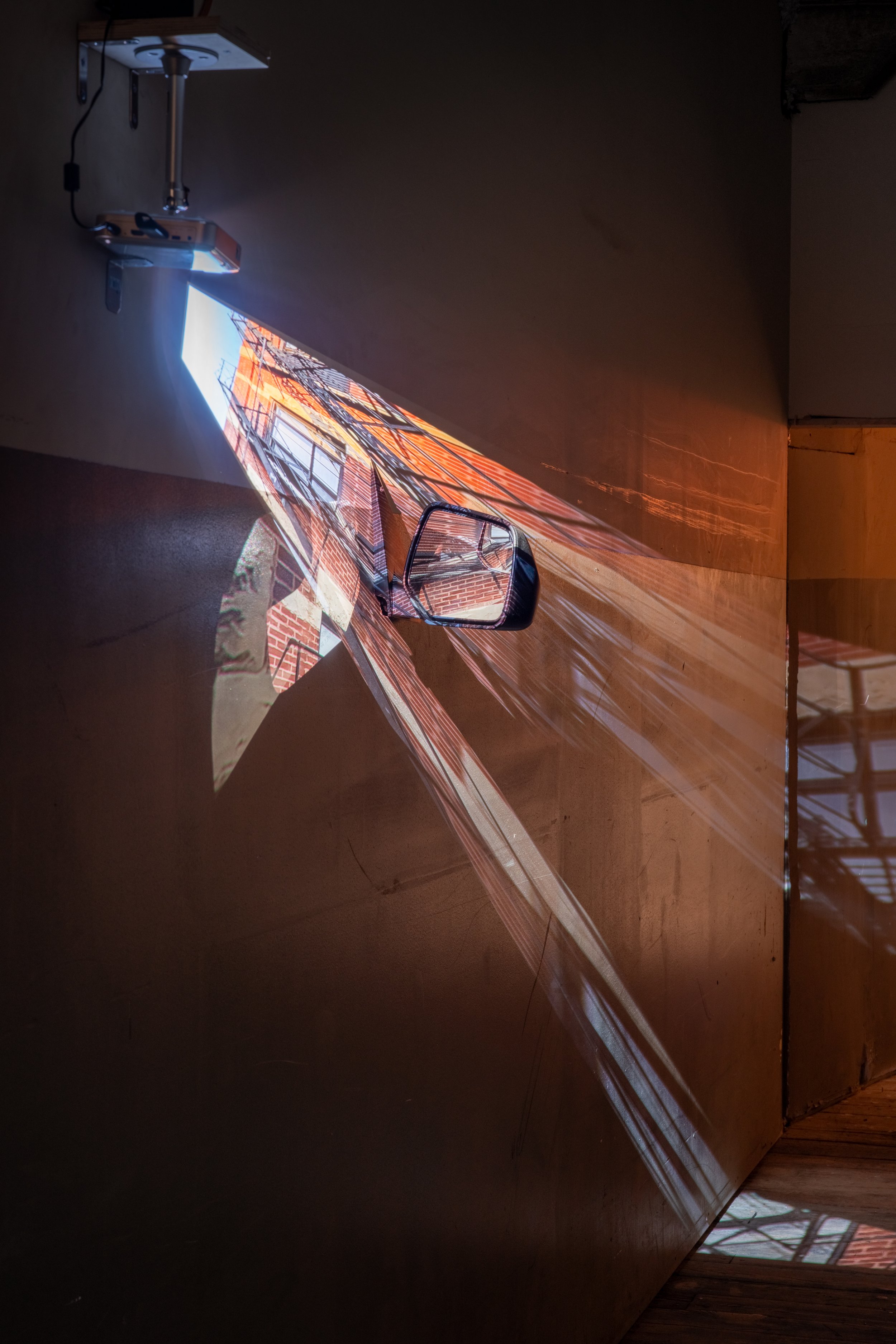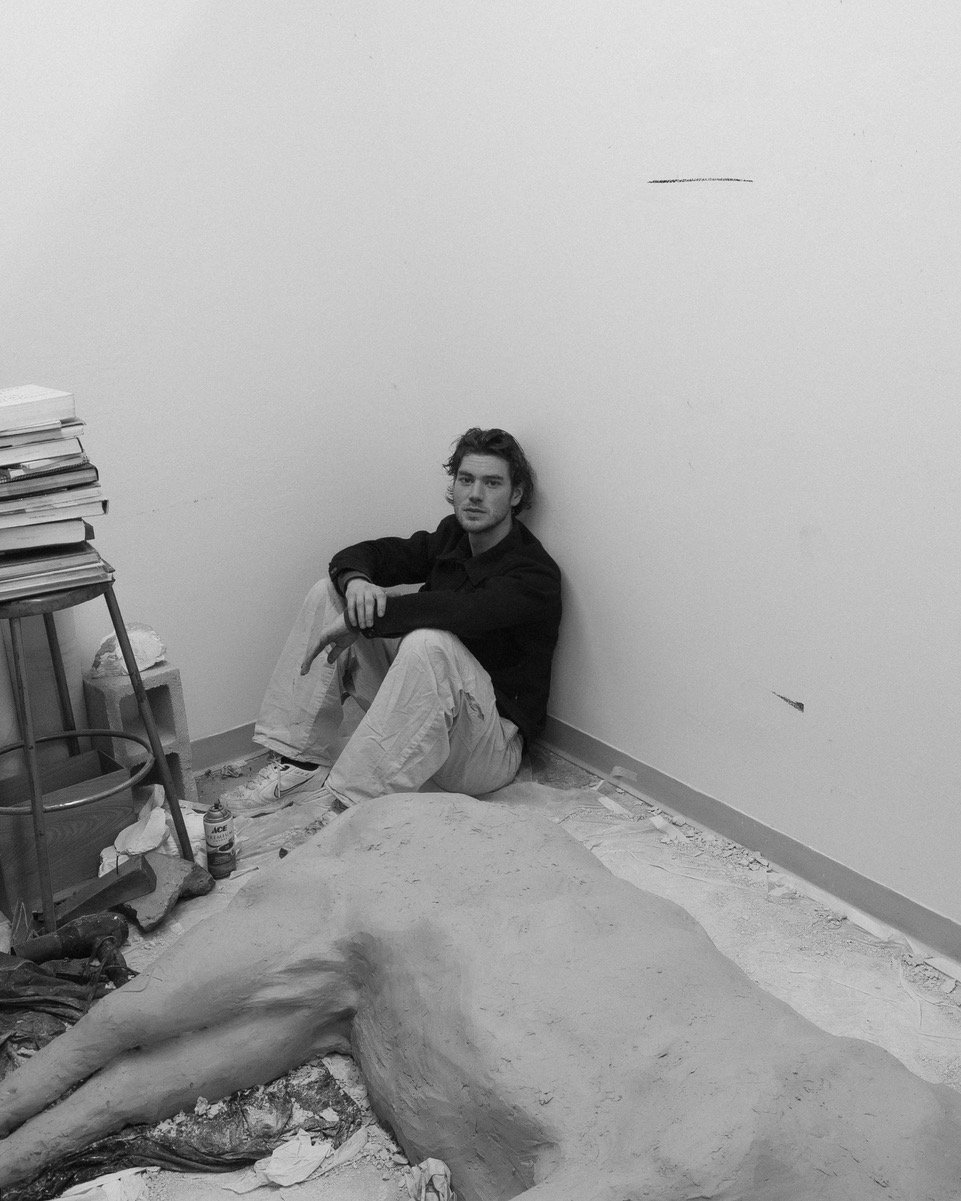Organized and curated by Philipp Groth (SF23) and Jonas Müller-Ahlheim, by bye Pilsen zooms in on artists’ vanishing spaces and gives Pilsen’s Cermak Center an epic sendoff.
When Philipp Groth found out Cermak Center was closing, he knew leaving was no simple matter of packing up his studio. He had to say goodbye to the building and to Pilsen while he was at it. Pilsen, the neighborhood that Cermak Center called home, has been an artistic hub for creatives, but in its most recent years, the area has become exorbitantly expensive. When the building was slated for demolition, Philipp knew this meant he’d have to find an entirely new part of Chicago to house his practice. But first, he had to bid the neighborhood farewell.
The idea for an exhibition came to fruition when artist Jonas Müller-Ahlheim came to visit Groth’s studio. “He shared this tragic story with me that they're gonna basically kick all the artists out, some of whom have been in the building for 20 years, [to] repurpose the building,” said Müller-Ahlheim. The building held a storied history as a Ford plant that had since lived several lives as studio spaces for artists. Groth and Müller-Ahlheim decided to use the gap of time after artists had moved out of the space and before the building was demolished. The timeline left them with less than three weeks to assemble a group of artists and install the work. With Groth and Müller-Ahlheim’s combined dedication and persuasion, it all came together.
Activating the space for them involved more than a traditional exhibition, they wanted the architecture to shine, to operate not just as a venue, but as an active, spotlighting part of the experience. This philosophy of activating existing structures was one that took root during Groth’s summer fellowship at Ox-Bow. In his own works at both Ox-Bow and in by bye Pilsen, Groth explained that he was “aiming to distill observable and imperceptible properties of materials and objects by installing works directly on the floor, in passageways, etc., so they automatically inherit architectural details such as the conditions of light or a site’s morphologies.” And while this same spirit of acknowledging the space made its way through all the artists’ works, each had their own philosophies and methods for how they achieved this.
“We saw ourselves more as facilitators than as curators,” Groth explained. Müller-Ahlheim elaborated that this allowed artists the permission to “[bring] in their own ideas,” that were both developed in and defined by the space. Ruby Que, for instance, brought in the site-specific installation “Closer,” which was developed at a residency and then adapted to the studio location. It featured a projection onto a Ford Escape mirror, paying homage to the building’s history as a former Ford plant. The video playing on a loop showed a drive around the neighborhood of Pilsen. The grainy nature of the projection gave it an air of nostalgia, fitting for a farewell. Müller-Ahlheim put the piece’s poeticism into words: “It was beautiful because the projection on the one hand, projects forward, but also the mirror projects backwards,” creating an embodiment of the studio space’s past and future lives.
The exhibition also included two works by Matthew Metzger, one of which left with quite the story attached. “Two works that influence the atmosphere of by bye Pilsen” included both a sound installation and a painting. The sound installation—a spun record’s eternal click, click, click—contributed its own wistful energy. But it was the painting that earned the story. After pulling a long night shift in the space, Groth and Müller-Ahlheim left the Cermak Center at 4:00 a.m. When Groth returned around 10:00 a.m., he was relieved to find everything from the projectors to the speakers still in place. With no budget and having run out of bike locks to secure the last room, the artists had put their faith in the universe, hoping that for six hours, the Metzger work would remain untouched. And everything did. Except, as Groth soon discovered that morning, Metzger’s painting, from which a clean cut of nearly a third of the canvas had been taken. Ironically, the piece was modeled after Manet’s “Episode from a Bullfight,” which was later split into two separate works: “The Dead Man” and “The Bullfight.” The piece had been with Metzger for over a decade and had even shown in major exhibitions. While rumors circulated that Metzger himself had torn the piece to add to the intrigue, Groth clarified that Metzger and his partner Miao Wang “were shocked standing in front of it.”
While deinstalling, Metzger consoled Groth and Müller-Ahlheim, saying that he knew the risk and felt the show was well worth it. And if the turnout says anything, it seems it was. Much like the lore surrounding Metzger’s piece, the exhibition developed a life and reputation of its own. When doors opened to the exhibition, over 300 people visited on its opening day. With folks congesting in hallways and conversing next to installations, the day itself became a manifestation of past, present, and future. Artists reunited and new friendships formed, all the while, a tangible grief for the loss of Cermak Center floated through the space. Yet, by bye Pilsen’s facilitators are hopeful that the exhibition becomes its own new beginning. In the future, Groth and Müller-Ahlheim intend to facilitate future happenings, ones that orchestrate new connections between creatives and generate an enthusiasm for what Chicago has to offer.
Exhibition Statement:
“by bye Pilsen” marks the farewell of Chicago’s Cermak Center, a former Ford plant pre-dating the modern assembly-line of Detroit and Chicago area factories. Having served as an artist space for the last 20 years, the warehouse in the Pilsen neighborhood is now slated for remodeling, allowing for a careful repurposing of its broached industrial floors.
A tribute to the site and the city at large, the group show highlights the work of a young generation of artists addressing the space between industry and poetics, and between the creation of progress and the creation of meaning. By bye Pilsen.
The exhibition included works by: Noelle Affrich, Tauba Auerbach, Kaya & Blank, Camille Casemier, Matthew Girson, Philipp Groth, Gordon Hall, Gary Lapointe, Makayla Lindsay, Matthew Metzger, Jonas Müller Ahlheim, Josue Pillot, Richard Rezac, Cameron Spratley, Aleksandra Walaszek, Ruby Que, and Xu Yue.
Philipp Groth is a German artist whose practice occupies intermediary positions between ready-made, autonomous, and site-sensitive demonstrations across various media including installation, sculpture, video, painting and drawing, and writing. He graduated from The University of the Arts London in 2021 and The School of the Art Institute of Chicago in 2023. From 2018 to 2020, he taught at the University of Applied Sciences SRH in Berlin. Groth’s work and research have been supported by grants and fellowships from the A4 Museum in Chengdu, The School of the Art Institute of Chicago, and Ox-Bow School of Art, where was named a LeRoy Neiman Fellow in 2023.
jonas müller-ahlheim (1993) is a German artist, curator, and educator, who works across multiple media including sculpture, painting, installation, performative acts, and video. The focus of his work lies on inconspicuous places in which he uses humor as a tool in order to understand the grammar of a situation. Material and thoughts are often gathered within his lived environment including his day job at a resale shop, photographer, and during his daily detours through the alleyways of Chicago. He studied Media Art at the Royal Academy of Fine Arts, Copenhagen and graduated in 2021 from The Art Academy Karlsruhe as a Meisterschüler with Professor Leni Hoffmann. From 2021 to 2023 he was awarded the DAAD - fellowship to continue his research at the Painting Department of the School of The Art Institute of Chicago (SAIC), from which he graduated with an MFA. In 2023 he was awarded a teaching fellowship at the School of the Art Institute of Chicago where he is currently a Lecturer.
This article was written by Shanley Poole, Engagement Liaison & Storyteller and was based on interviews conducted in September 2024.
Image List:
Josue Pillot, Untitled, Inkjet print, Documentation of Damas a Caballo series, 2010-2012
Ruby Que, Closer, Ford Escape side mirror, digital projection, 2024
Philipp Groth, Umbau (Detail), steel, screws, wood, and paint, 2024
Matthew Metzger, Two works that influence the atmosphere of by bye Pilsen, 2024
(left) Noelle Africh, Loomer, distemper on linen over panel, 20 x 16 inches, 2023
(center) Gordon Hall, Closed Box with Painted Top, cast concrete, poplar, latex paint, 12 x 18 x 11 inches, 2019
(right) Gary Lapointe, flexible measure, 3 ruler stack, altered rulers and hardware, 3 feet x 1 inch x 1 inch, 2019
Headshot of Philipp Groth.
All images courtesy of Philipp Groth.






